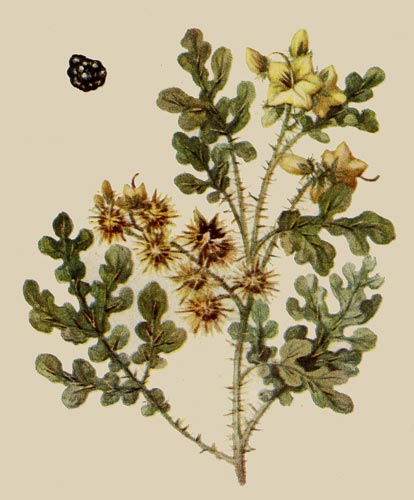Weeds
Solanum cornutum Lam. - Buffalobur.
Taxonomic position.
Family Solanaceae Juss., genus Solanum L.Synonyms.
Solanum rostratum Dun.Biological group.
Spring annual weed.Morphology and biology.
Plant is 30-100 cm in height, densely covered with stellate hairs. Stem, branches, petioles and leaf ribs, flower stalks and calyx are also covered with firm subulate stramineous thorns 5-12 mm in length. Stem is cylindrical, ligneous, highly branched, dusty-greyish in colour. One freely growing plant can produce up to 70 branches, the diameter of bush can reach 70 cm. Tap root is branched, penetrating down to depths of 3 m. Leaves are alternate, with long petioles, lyrate, deeply pinnatipartite, 5-10 cm in length. Flowers are divided into 5 parts. At first flowers are aggregated at the end of short (2-3 cm) flower stalk, later they are arranged in a raceme due to stalk elongation. Corolla is yellow, 2-3 cm in diameter, with lanceolate-ovate lobes. Calyx has ovate-lanceolate lobes, enlarged and nearly globular during fruiting, tightly fitting the berry. This plant flowers in June-September, bears fruits in August-October. Fruit is a unilocular globular semidry berry. Fruit dehisces when ripe. One plant can produce up to 180 berries; each of them contains 50-120 seeds. Seeds are dark-brown or black, rounded-reniform, compressed laterally; their surface is reticular and wrinkled. Newly ripened seeds do not germinate; they have to be dormant for 5-6 months, germinating only after over-wintering in soil. Seed viability can be maintained in soil for 10 years. Minimum temperature for seed germination is 10-12°C, optimum is 22-25°C. Seeds can germinate from depths of 1-15 cm, germinating best of all from depths of 3-5 cm. S.cornutum only propagates by seeds; after seeds ripen the plants easily break off from their roots, rolling for great distances with the help of wind. After shattering, the seeds of S.cornutum are spread by wind and mud splatter from wheels of vehicles.Distribution.
S.cornutum is an adventive weed; its homeland is Mexico and the southwest USA. It occurs in the European part of the Former Soviet Union, in the Caucasus, Kazakhstan, the Far East. General distribution: North America, adventive weed in Middle Europe, Mediterranean, Australia, South Africa. Potential area of S.cornutum can reach latitude 60°N.Ecology.
Rather heat-loving plant. S.cornutum grows on all types of soils, but better on loose, alkaline loam or clay soils. This plant prefers well-illuminated places.Economic significance.
S.cornutum is a pernicious quarantine weed. It infests tilled and spring grain crops, gardens, vegetable gardens, and pastures. As a ruderal plant it occurs along roads, in waste places, in uncultivated lands. Due to its deep and branched root system buffalobur successfully competes with cultivated plants for nutrients and moisture, which determines its high weediness. Leaves of S.cornutum are poisonous for animals. Getting into hay and straw, thorns of this plant damage the digestive system of animals. S.cornutum is a plant host for some pests and pathogens of Solanaceae (Colorado potato beetle, potato moth, tobacco mosaic virus, Verticillium albo-atrum). Seeds of this plant are rich in oil which can be used for industrial and food purposes. Control measures include quarantine phytosanitary actions (prevention of seed spread into new regions, systematic survey of lands, eradication of initial and isolated foci of S.cornutum); prophylactic measures (thorough purification of crop seeds, fertilization by well-decomposed manure); agronomic measures (mowing weed before flowering in uncultivated lands, use of clean or full fallows in crop rotation with subsequent sowing of winter cereals for two years, early autumn plowing, shallow plowing); measures of chemical control (use of herbicides).Reference citations.
Basset, I.J. & Munro, D.B. 1986. The biology of Canadian weeds. 78. Solanum carolinense L. and Solanum rostratum Dunal. Canadian Journal of Plant Sciences. 66(10): 977-91.Chebotar, A.A., ed. 1989. Plants of steppes and limestone slopes, and weeds. Kishinev: Shtiintsa. 304 p. (in Russian).
Moskalenko, G.P. 2001. Quarantine weeds of Russia. Moscow: Rosgoskarantin. 280 pp. (in Russian).
Nikitin, V.V. 1983. Weed plants of the USSR flora. Leningrad: Nauka. 454 p. (in Russian).
Shishkin, B.K. & Bobrov, E.G., ed. 1955. Flora of the USSR. V.22. Moscow-Leningrad: AN SSSR. 861 p. (in Russian).
Ulyanova, T.N. 1998. Weed plants in flora of Russia and other CIS countries. St.Petersburg: VIR. 343 p. (in Russian).


